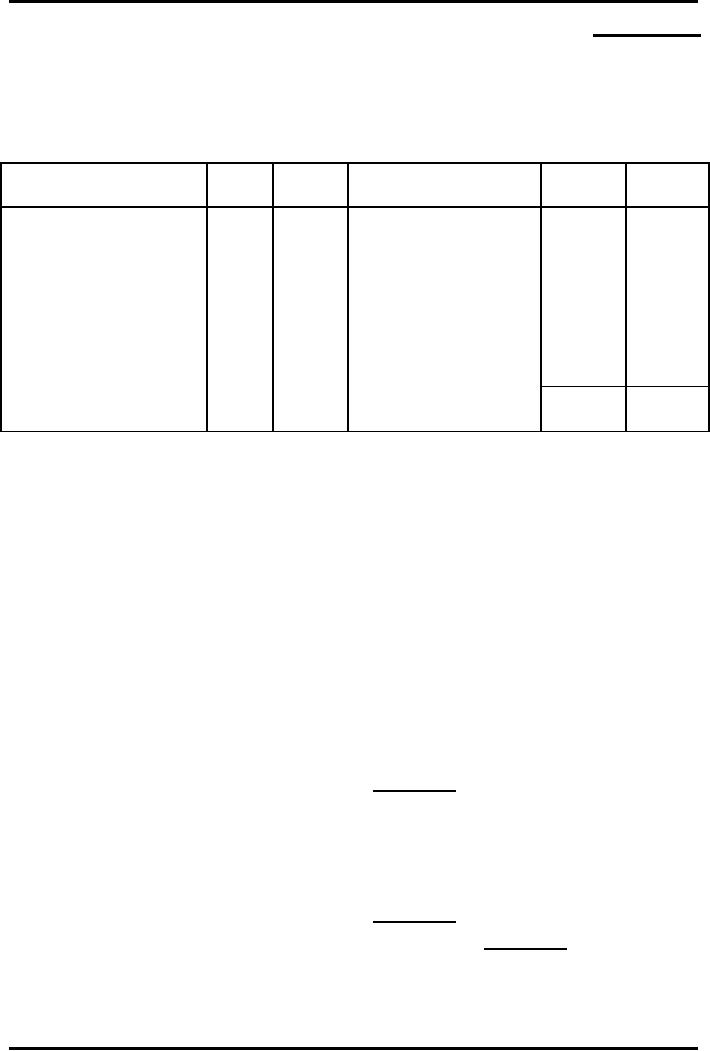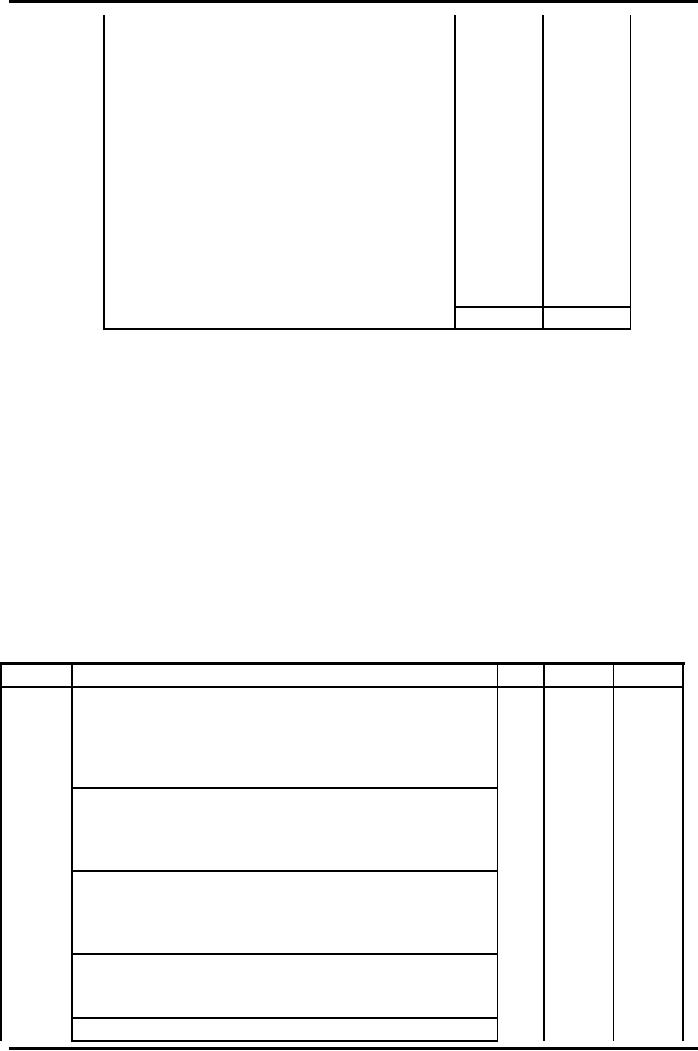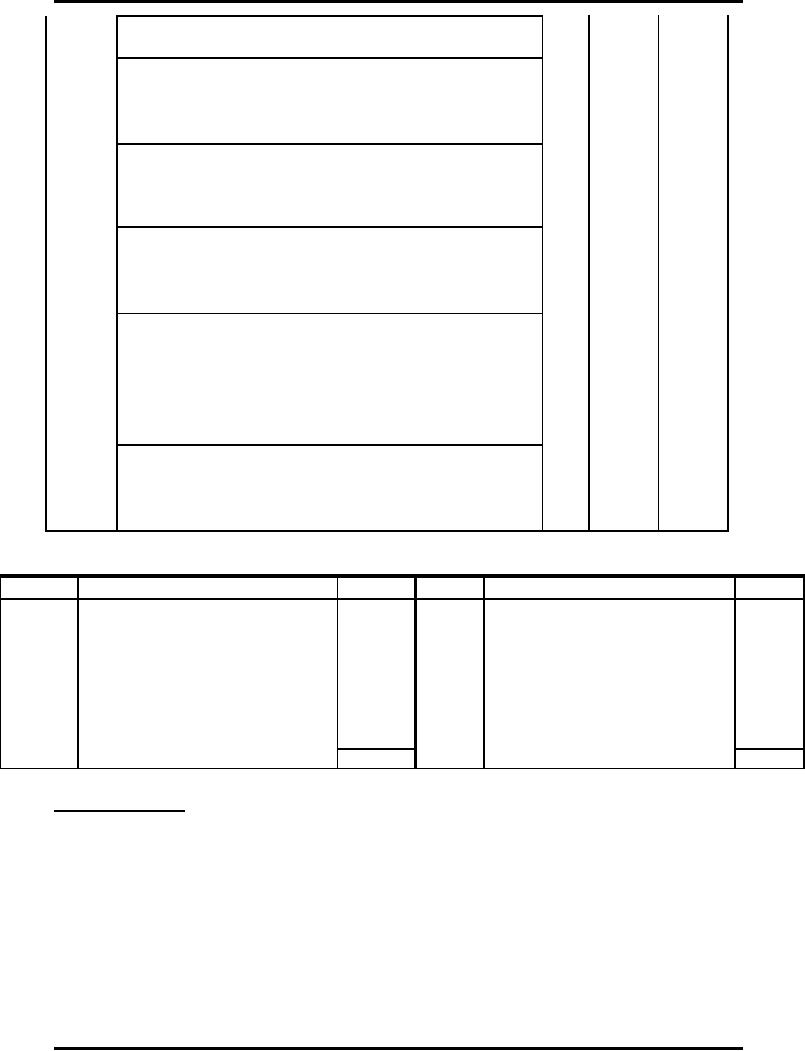 |
BRANCH ACCOUNTING 1 |
| << INDEPENDENT BRANCH |
| BRANCH ACCOUNTING 2 >> |

Advance
Financial Accounting
(FIN-611)
VU
LESSON
# 16
BRANCH
ACCOUNTING
(Incorporation of
branch)
Question
The
following is the Trial Balance of
Murree Branch as on 31st December, 2007.
Dr.
Cr.
Dr.
Cr.
(Rs.)
(Rs.)
(Rs.)
(Rs.)
Lahore
head office
Debtors
3,700
3,240
Stock
1st Jan. 2007
Creditors
6,000
1,850
Purchases
97,800
Rent
1,960
19,000
Sundry
office
1,470
Goods
received from H
138,000
expenses
1,780
O
6,000
Cash at bank
6,000
Sales
Goods
supplied to
Furniture
400
Depreciation
on
4,500
head
office / Sales to H
Furniture
O
145,850
145,850
Salaries
Other
Information:
Stock
at branch on 31st
December 2007
was valued at Rs.
7,700.
Murree
Branch Account in the head
office books on 31st December, 2007 stood at
Rs.
460
(debit balance). On 28th December, 2007 the head
office forwarded goods of
the
value
of Rs. 3,700 to the branch
where they were on 3rd January, 2007.
Solution
Murree
Income
Statement
For
the year ended 31st December, 2007
Sales
138,000
Goods
supplied to H O
6,000
144,000
Less
CGS
Opening
Stock
6,000
Add
Purchases
97,800
Goods
received from H O 19,000
Less
Closing Stock
7,700
115,100
Gross
Profit
28,900
72

Advance
Financial Accounting
(FIN-611)
VU
Less
operating Expenses
Salaries
4,500
Rent
1,960
Sundry
Office Expenses
1,470
Depreciation
on Furniture
400
8,330
Net
Profit
20,570
Murree
Income
Statement
For
the year ended 31st December, 2007
Sales
138,000
Goods
supplied to H O
6,000
144,000
Less
CGS
Opening
Stock
6,000
Add
Purchases
97,800
Goods
received from H O 19,000
Less
Closing Stock
7,700
115,100
Gross
Profit
28,900
Less
operating Expenses
Salaries
4,500
Rent
1,960
Sundry
Office Expenses
1,470
Depreciation
on Furniture
400
Advertisement
on Equipment 1,000
Depreciation
on Furniture
500
9,830
Net
Profit
19,070
Incorporation
of Branch Trial Balance in
the Head Office
Books
It
has already been stated
that an independent branch
prepares its own Trial
Balance
and
Final Accounts and remits
the copies of these
statements to the head
office.
After
receiving Branch Trial
Balance, head office
proceeds to incorporate it in its
own
books.
This is absolutely necessary
because the branch belongs
to the head office,
and
if
the branch Trial Balance is
not incorporated in the head
office books, the latter
will
not show
correct position.
73

Advance
Financial Accounting
(FIN-611)
VU
The
incorporation of Branch Trial
Balance can be divided into two
parts:
a.
Incorporation of Branch Profit and
Loss
b.
Incorporation of Branch Assets and
Liabilities
Incorporation
of Branch Profit and
Loss
For
the purpose of incorporation of
branch profit and loss, the
head office may follow
any of
the following two methods:
i.
Detailed
Incorporation
ii.
Abridged
Incorporation
Detailed
Incorporation
Under
this method, incorporation is
done with a view to prepare Branch
Trading
and
Profit and Loss Account in
the books of the head
office. Head office opens
a
separate
Branch Trading and Profit and
Loss Account to incorporate all
revenue
transactions
of the branch. This account
is temporary in nature and is prepared
to
ascertain
the real profit or loss of
the branch after making all
adjustments.
In
this connection, we must remember
that head office maintains
only the Branch
Account
and the statements received from
the branch do not form a part of
the
double
entry system. Therefore, all the
Journal Entries should be
passed through
the
Branch Account maintained in
the head office. The
required Journal Entries
are
as
follows:
Journal
Entries
1.
For items on the debit
side of the Branch Trading
Account
Branch
Trading Account
To
Branch Account
[The
above entry is passed for
the total amount of items
like opening stock, purchases,
carriage
inwards,
wages, processing cost, goods
received from head office,
sales returns, etc.]
2.
For items on the credit
side of the Branch Trading
Account
Branch
Account
To
Branch Trading
Account
[The
above entry is passed for
the total amount of items
like sales, goods sent to
head office,
closing
stock, purchases returns,
abnormal loss of stock,
etc.]
3.
For items on the debit
side of the Branch Profit
and Loss Account
Branch
Profit and Loss
Account
To
Branch Account
[The
above entry is passed for
the total amount of items
like salaries, rent, depreciation,
bad
debts,
repairs, discount allowed,
etc.]
4.
For items on the credit
side of the Branch Profit
and Loss Account
Branch
Account
74

Advance
Financial Accounting
(FIN-611)
VU
To
Branch Profit and Loss
Account
[The
above entry is passed for
the total amount of items
like discount received,
miscellaneous
income,
etc.]
Abridged
Incorporation
Under
this method, a Memorandum Trading and
Profit and Loss Account
is
prepared
for ascertaining branch profit. Only
one entry is passed for
incorporating
branch
net profit/loss.
Branch
Account
To
General Profit and Loss
Account
[In
case of loss the above entry
shall be reversed.]
Incorporation
of Branch Assets and
Liabilities
This
part of the incorporation is
done with a view to include branch assets
and
liabilities
in the annual Balance Sheet
of the whole business. At the
beginning of the
new
financial year, assets and liabilities
are sent back to the
books of the branch
by
means
of reverse entries.
For
the purpose of incorporation,
the following entries are
passed:
Journal
Entries
1.
For Branch Assets
Branch
Assets Accounts
Dr.
[Individually]
To
Branch Account
2.
For Branch
Liabilities
Branch
Account
Dr.
[Individually]
To
Branch Liabilities
Account
Question
Babar
Co. Ltd. of Islamabad had a branch in
Sahiwal which maintained its
accounts
independently.
Accounts relating to fixed assets in
the Sahiwal branch were,
however,
kept
in the books of accounts of
the head office. On 31st December, 2006 the
Sahiwal
branch
extracted the following Trial
Balance from its own books of
accounts and
forwarded
the same to the head
office.
Particulars
Dr.
(Rs)
Cr.
(Rs)
Stock
in Trade (01.01.2006)
20,000
Purchases
50,000
Carriage
and Freight Inward
2,500
Goods
Received from head
office
15,000
Transit
insurance on goods
received
1,000
75

Advance
Financial Accounting
(FIN-611)
VU
Salaries
10,000
Rents
rates and taxes
3,800
General
office expenses
9,000
Sundry
debtors
7,200
Cash
in hand and at bank
2,500
Sales
75,900
Sundry
creditors
5,000
Miscellaneous
receipts
500
Purchases
returns
800
Sales
returns
500
Bills
receivable
1,500
Discount
allowed
200
Head
office account
41,000
Total
1,23,200
1,23,200
The
closing stock (as at
31.12.2006) at Sahiwal branch
was Rs. 16,000. Depreciation
was
to be
allowed @ 15% p.a. on Branch
Plant and Machinery of Rs. 25,000 and @
20% p.a.
on
Branch Furniture and Fittings of
Rs. 6,000. Outstanding rent
in respect of the
year
2006
amounted to Rs. 500. Sahiwal
Branch account, in the head
office books, showed
a
debit
balance of Rs. 46,000 and it
was revealed that the
difference in the
balances
shown by
Head Office Account and
Sahiwal Branch Account was
on the account of
cash-in-transit.
You
are to show Journal Entries
required to incorporate the
above Trial Balance
and
other
particulars in the books of
the head office and also
the Sahiwal Branch
Account.
In
the books of Babar Co.
Ltd. (H.O.)
Journal
Dr.
Cr.
Date
Particulars
L.F.
Rs.
Rs.
89,000
2006
Sahiwal
Branch Trading A/c
Dec,
To
Sahiwal Branch A/c (Note
1)
89,000
[Being
the incorporation of opening
stock, purchases,
31
carriage
and freight inward, goods
received from head
office,
transit
insurance, sales returns
etc]
92,700
Sahiwal
Branch A/c
To
Sahiwal Branch Trading A/c
(Note 2)
92,700
[Being
the incorporation of closing
stock, sales and
purchase
returns]
Sahiwal
Branch Trading A/c
3,700
To
Sahiwal Branch Profit &
Loss A/c
3,700
[Being
the gross profit transferred to
Branch Profit & Loss
Account]
Sahiwal
Branch Profit & Loss
A/c
28,450
To
Sahiwal Branch A/c (Note
3)
28,450
[Being
the incorporation of branch
expenses]
Sahiwal
Branch A/c
500
76

Advance
Financial Accounting
(FIN-611)
VU
To
Sahiwal Branch Profit &
Loss A/c
500
[Being
the incorporation of branch
miscellaneous income]
General
Profit and Loss A/c
24,250
Dr.
24,250
To
Sahiwal Branch Profit &
Loss A/c
[Being
the incorporation of branch
net loss]
5,000
Cash
in Transit
To
Sahiwal Branch A/c
5,000
[Being
cash remitted by Sahiwal
Branch not yet received
by
the
H.O.]
4,950
Sahiwal
Branch A/c
To
Branch Plant & Machinery
A/c
3,750
1,200
To
Branch Furniture & Fittings
A/c
[Being
the depreciation charges on branch
assets]
Sahiwal
Branch Closing Stock
A/c
16,000
Sahiwal
Branch Debtors A/c
Dr.
7,200
Sahiwal
Branch Bills Receivable
A/c
1,500
Sahiwal
Branch Cash in hand A/c
2,500
To
Sahiwal Branch A/c
27,200
[Being
the incorporation of branch
assets]
Sahiwal
Branch A/c
5,500
To
Sahiwal Branch Creditors
A/c
5,000
To
Outstanding Rent A/c
500
[Being
the incorporation of branch
liabilities]
In
the books of the Babar
Co. Ltd. (H.O.)
Sahiwal
Branch Account
Date
Particulars
Rs.
Date
Particulars
Rs.
46,000
89,000
31.12.06
To Balance
b/d
31.12.06
By
Sahiwal Branch Trading
A/c
To
Sahiwal Branch Trading
A/c
(Note
1)
92,700
(Note
2)
By
Sahiwal Branch Profit &
Loss
28,450
To
Sahiwal Branch Trading
A/c
A/c
500
To
Branch Plant & Machinery
A/c
By Cash in
Transit A/c
3,750
5,000
To
Branch Furniture & Fittings
A/c
By
Sahiwal Branch Assets
A/c
1,200
27,200
To
Sahiwal Branch Creditors
A/c
5,000
To
Outstanding Rent A/c
500
1,49,650
1,49,650
Working
Notes:
1.
Opening
stock Rs. 20,000 + Purchases
Rs. 50,000 + Carriage and Freight
Rs.
2,500
+ Goods from head office Rs.
15,000 + Transit insurance Rs.
1,000 + Sales
Return
Rs. 500 = Rs. 89,000.
2.
Sales
Rs. 75,900 + Closing Stock
Rs. 16,000 + Purchase Returns
Rs. 800 = Rs.
92,700.
3.
Salaries
Rs. 10,000 + Rent rates
(including outstanding) Rs.
4,300 + General
office
expenses Rs. 9,000 +
Discount allowed Rs. 200 +
Depreciation on Plant
and
Machinery Rs. 3,750 +
Depreciation on Furniture and Fittings
Rs. 1,200 =
Rs.
28,450.
77
Table of Contents:
- ACCOUNTING FOR INCOMPLETE RECORDS
- PRACTICING ACCOUNTING FOR INCOMPLETE RECORDS
- CONVERSION OF SINGLE ENTRY IN DOUBLE ENTRY ACCOUNTING SYSTEM
- SINGLE ENTRY CALCULATION OF MISSING INFORMATION
- SINGLE ENTRY CALCULATION OF MARKUP AND MARGIN
- ACCOUNTING SYSTEM IN NON-PROFIT ORGANIZATIONS
- NON-PROFIT ORGANIZATIONS
- PREPARATION OF FINANCIAL STATEMENTS OF NON-PROFIT ORGANIZATIONS FROM INCOMPLETE RECORDS
- DEPARTMENTAL ACCOUNTS 1
- DEPARTMENTAL ACCOUNTS 2
- BRANCH ACCOUNTING SYSTEMS
- BRANCH ACCOUNTING
- BRANCH ACCOUNTING - STOCK AND DEBTOR SYSTEM
- STOCK AND DEBTORS SYSTEM
- INDEPENDENT BRANCH
- BRANCH ACCOUNTING 1
- BRANCH ACCOUNTING 2
- ESSENTIALS OF PARTNERSHIP
- Partnership Accounts Changes in partnership firm
- COMPANY ACCOUNTS 1
- COMPANY ACCOUNTS 2
- Problems Solving
- COMPANY ACCOUNTS
- RETURNS ON FINANCIAL SOURCES
- IASB’S FRAMEWORK
- ELEMENTS OF FINANCIAL STATEMENTS
- EVENTS AFTER THE BALANCE SHEET DATE
- PROVISIONS, CONTINGENT LIABILITIES AND CONTINGENT ASSETS
- ACCOUNTING POLICIES, CHANGES IN ACCOUNTING ESTIMATES AND ERRORS 1
- ACCOUNTING POLICIES, CHANGES IN ACCOUNTING ESTIMATES AND ERRORS 2
- BORROWING COST
- EXCESS OF THE CARRYING AMOUNT OF THE QUALIFYING ASSET OVER RECOVERABLE AMOUNT
- EARNINGS PER SHARE
- Earnings per Share
- DILUTED EARNINGS PER SHARE
- GROUP ACCOUNTS
- Pre-acquisition Reserves
- GROUP ACCOUNTS: Minority Interest
- GROUP ACCOUNTS: Inter Company Trading (P to S)
- GROUP ACCOUNTS: Fair Value Adjustments
- GROUP ACCOUNTS: Pre-acquistion Profits, Dividends
- GROUP ACCOUNTS: Profit & Loss
- GROUP ACCOUNTS: Minority Interest, Inter Co.
- GROUP ACCOUNTS: Inter Co. Trading (when there is unrealized profit)
- Comprehensive Workings in Group Accounts Consolidated Balance Sheet